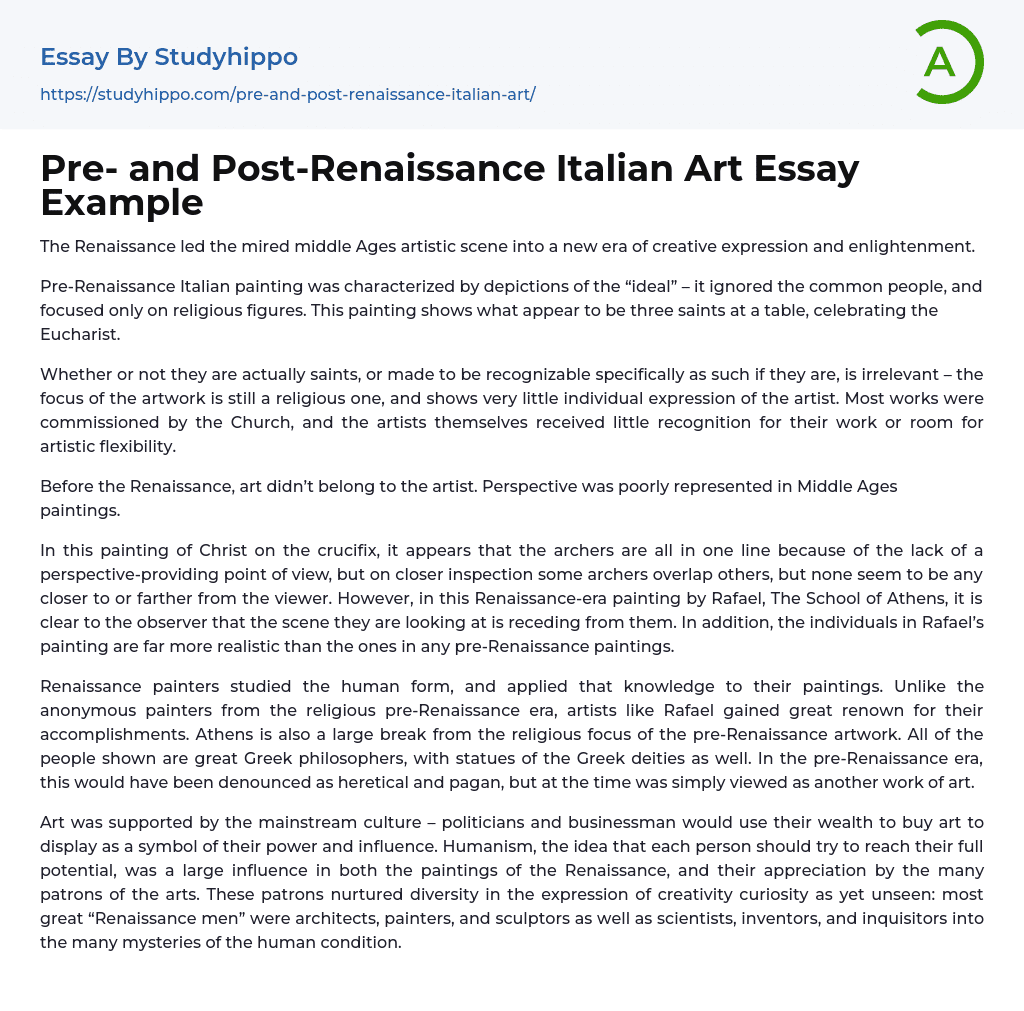The Renaissance led the mired middle Ages artistic scene into a new era of creative expression and enlightenment.
Pre-Renaissance Italian painting was characterized by depictions of the “ideal” – it ignored the common people, and focused only on religious figures. This painting shows what appear to be three saints at a table, celebrating the Eucharist.
Whether or not they are actually saints, or made to be recognizable specifically as such if they are, is irrelevant – the focus of the artwork is still a religious one, and shows very little individual expression of the artist. Most works were commissioned by the Church, and the artists themselves received little recognition for their work or room for artistic flexibility.
Before the Renaissance, art didn’t belong to the artist. Perspective was poorly represented in Middle Ages paintings.
...In this painting of Christ on the crucifix, it appears that the archers are all in one line because of the lack of a perspective-providing point of view, but on closer inspection some archers overlap others, but none seem to be any closer to or farther from the viewer. However, in this Renaissance-era painting by Rafael, The School of Athens, it is clear to the observer that the scene they are looking at is receding from them. In addition, the individuals in Rafael’s painting are far more realistic than the ones in any pre-Renaissance paintings.
Renaissance painters studied the human form, and applied that knowledge to their paintings. Unlike the anonymous painters from the religious pre-Renaissance era, artists like Rafael gained great renown for their accomplishments. Athens is also a large break from the religious focus of the pre-Renaissance artwork.
All of the people shown are great Greek philosophers, with statues of the Greek deities as well. In the pre-Renaissance era, this would have been denounced as heretical and pagan, but at the time was simply viewed as another work of art.
Art was supported by the mainstream culture – politicians and businessman would use their wealth to buy art to display as a symbol of their power and influence. Humanism, the idea that each person should try to reach their full potential, was a large influence in both the paintings of the Renaissance, and their appreciation by the many patrons of the arts. These patrons nurtured diversity in the expression of creativity curiosity as yet unseen: most great “Renaissance men” were architects, painters, and sculptors as well as scientists, inventors, and inquisitors into the many mysteries of the human condition.
- Creativity essays
- Art History essays
- Theatre essays
- Pastoral essays
- Visual Arts essays
- Postmodernism essays
- Symbolism essays
- ballet essays
- Color essays
- Modernism essays
- Mona Lisa essays
- Work of art essays
- Body Art essays
- Artist essays
- Cultural Anthropology essays
- Ethnography essays
- Aesthetics essays
- Realism essays
- Heritage essays
- Harlem Renaissance essays
- Concert Review essays
- Voice essays
- Theatre Of The Absurd essays
- Playwright essays
- Scotland essays
- Tennessee williams essays
- Design essays
- Graffiti essays
- Graphic essays
- Typography essays
- Painting essays
- Photography essays
- Sculpture essays
- Architecture essays
- Interior design essays
- Arch essays
- Area essays
- Tattoo essays
- Pablo Picasso essays
- Vincent Van Gogh essays
- Michelangelo essays
- Frida Kahlo essays
- John Locke essays
- 9/11 essays
- A Good Teacher essays
- A Healthy Diet essays
- A Modest Proposal essays
- A&P essays
- Academic Achievement essays
- Achievement essays




